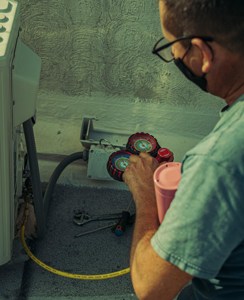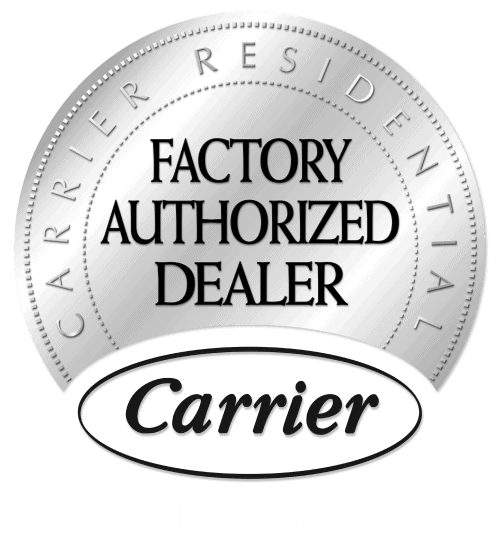Dealing with a clogged condensate drain line is one of the problems homeowners deal with on a regular basis. Although clogging can be daunting to deal with, it is easy to notice and fix, and you can either try to solve the problem yourself or hire an expert to help you unclog your drain line.
Once you notice an issue with your drain line, the first step is to find the cause of the clog, as this is essential to knowing what to repair after dealing with the mess. You can unclog the drain with a vinegar solution using the steps we’ll mention later in the article.
What Is An AC Condensate Drain Line?
The HVAC absorbs excess heat and humidity to make the rooms comfortable. Once the moisture gets inside the system, it cools and condenses onto the metal coils. The cooled water is then transported into the drain line to the outside.
When the drain line clogs, water cannot exit the system. Instead, it accumulates and fills the drain pan, causing a malfunction in the system. It is easy to notice a clogged drain line. If you suspect a blockage on yours, check for these signs.
Signs Your Condensate Drain Line Clogged
You can only unclog a drain line that you’ve seen the signs of clogging. Here are the signs that your condensate drain line is clogged.
1. Water Flooding In The Area Around The Water Pan
If you’ve lived with your unit long enough, you know the areas around the system that are always dry. If you notice signs of wetness around the unit, it could be due to a clogged drain line. The clog blocks water from exiting and over-floods the drain pan down to the floor.
2. Malfunctioning Of Your Unit
Another sign of a blocked drain line is ineffectiveness in your system. Malfunctions can be due to severe issues like power supply, mechanical damage, and clogged drain lines.
You must, however, first inspect the system to know the reason for ineffectiveness. Call an HVAC expert if you don’t have enough expertise to do the inspection.
3. Mold And Musty Smell In The House
Ever experienced a leaking tap in your home? It moistens the home, and the house gets a musty smell with time. The smell is due to mold growth because mold thrives well in a wet environment.
A musty smell in your home with an ineffective HVAC could be due to clogging. The musty smell is due to the moisture, which could cause other damage to your floor, furniture, and carpets.
4. Full Condensate Pan
An AC’s drain pan collects water when a clogged drainpipe exists. How often does your condensate pan fill? If you empty it more often, it could be a sign that the drain pipe is blocked. Call an expert to check and repair it to avoid floor damage by mold.
How to Fix Clogged Condensate Drain Line
Now that you can tell when your condensate drain line is clogged, it is time for repairs. You can DIY some repairs, but you must hire an expert to deal with others. Follow this step-by-step method to clean your drain pipe.
1. Switch Off The Power Supply
Before working on your AC, ensure the breaker of your AC is off. Working on a plugged-in machine can cause electric accidents like shocks, which can be fatal. It can also cause the fuses in the device to blow.
2. Locate The Drain Line
Once you shut off the power supply, the next step is to look for the AC drain line. It is a PVC pipe found near the condenser unit. Check to see any stagnant water in the drain pan or if there are clogs in the drain line.
If the drain pans are full, use an old dry rag to suck the water. You can drain the water using a wet vacuum and clean the pan. However, leaving it wet can lead to mold growth, causing a musty smell in the home.
3. Check The Drain Line For Clogs
If there is stagnant water in the drain pan, there are high chances the drain pipe will get clogged. You should find the reason for the clogs. Accumulated debris, mold, and algae cause most drain line clogs due to the moisture in the drain line and dirt.
Wear protective gloves to remove the line’s dirt, debris, algae, or mold. Some clogs are too big, requiring you to use objects to push them outside. However, be extra careful not to tear your drain line.
4. Unclog With Vinegar Solution
If you cannot pull the clog outside, flush the pipe with vinegar solution. Vinegar is a safe cleaning agent that breaks down dirt and clogs and makes them move through the pipes.
Mix vinegar with water and soap and pour it into the pipe. You can also use bleach to break down the dirt, but ensure it has friendly properties with PVC. Once you pour the solution into the pipe, let it sit for about 30 minutes.
Pour clean water and let it flow through the pipes to flush the dirt. The clog is still present if you notice the water is slow or does not flow effectively. You will need a professional to clean it.
Preventing Drain Line Clogs
Even though you know how to fix a clogged condensate drain line, you should keep them clean to ensure they don’t block. Do so by pouring a cup of vinegar solution or bleach down the lines to break down any clogs.
Vinegar and bleach solutions control mold and algae growth caused by stagnant water. They also ensure no musty or mold smell in the home, protecting our family from respiratory problems.
You should also change or replace your air filters to ensure no debris and dirt find their way into the drain lines. These are huge causes of clogs, and they reduce the effectiveness of the AC.
Failing to clean a clogged drain line can cause respiratory problems in your family. It happens when the rooms are musty due to mold growth and dampness.
Final Words
Cleaning a clogged condensate drain line is quick and straightforward if you know what you’re doing. Once you see the signs of clogging, use safety gloves to remove the clog from the drain pipe. Next, pour a vinegar solution to remove the remaining clogs and prevent mold growth.
If you’re not comfortable going about unclogging the condensate drain line by yourself, Hurliman is always here to help. Give us a call to have one of our trained technicians handle it for you, with no fuss or hassle.






